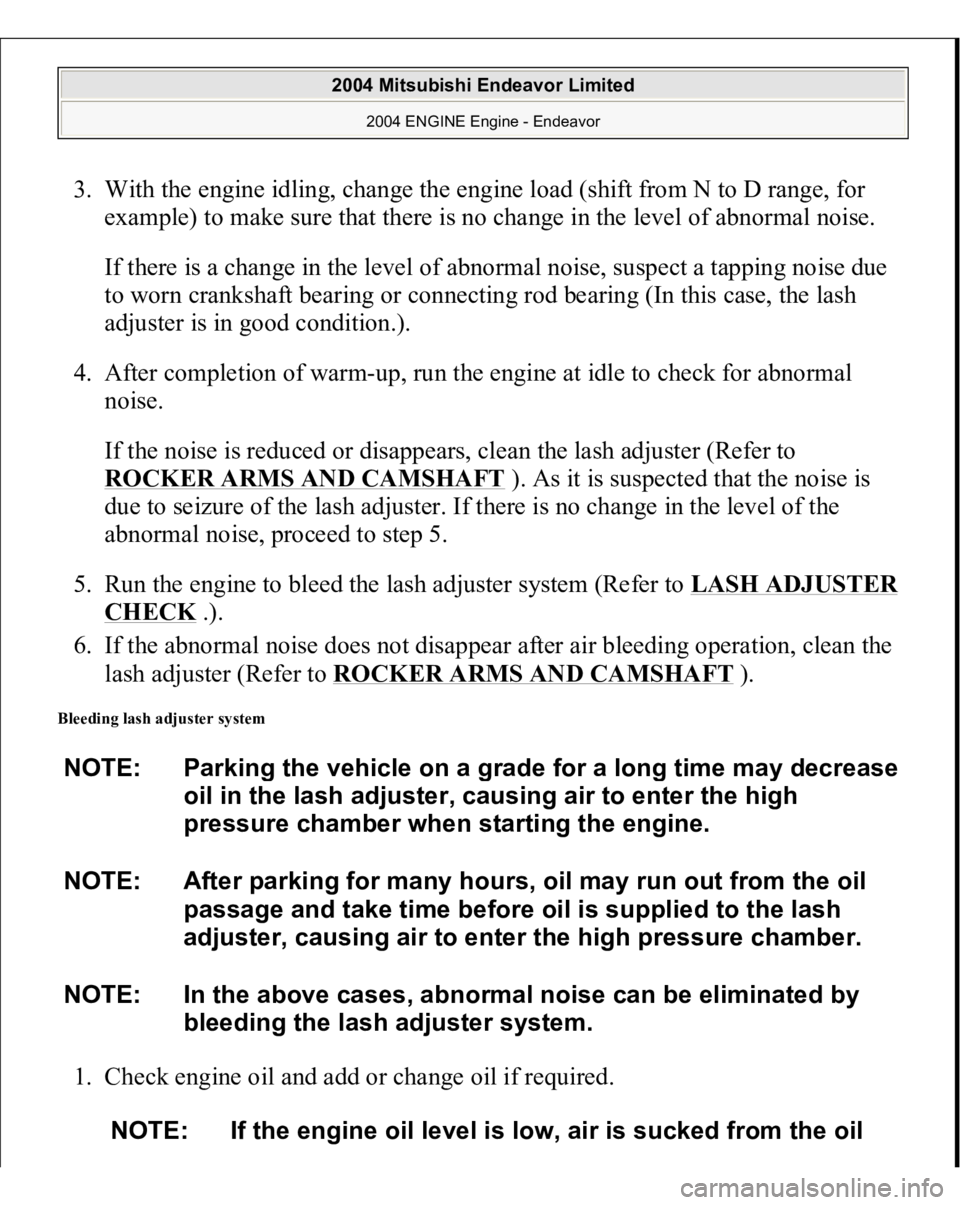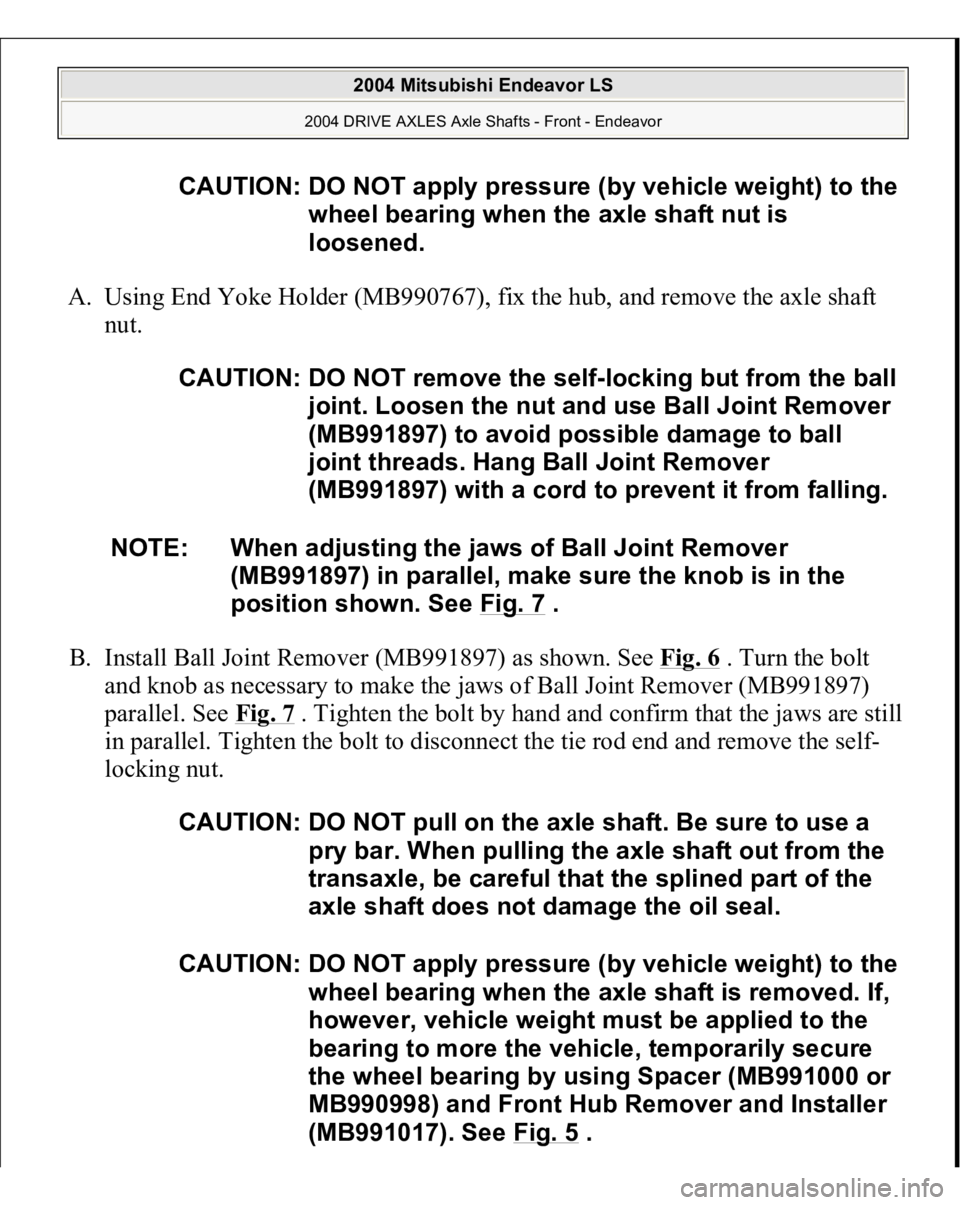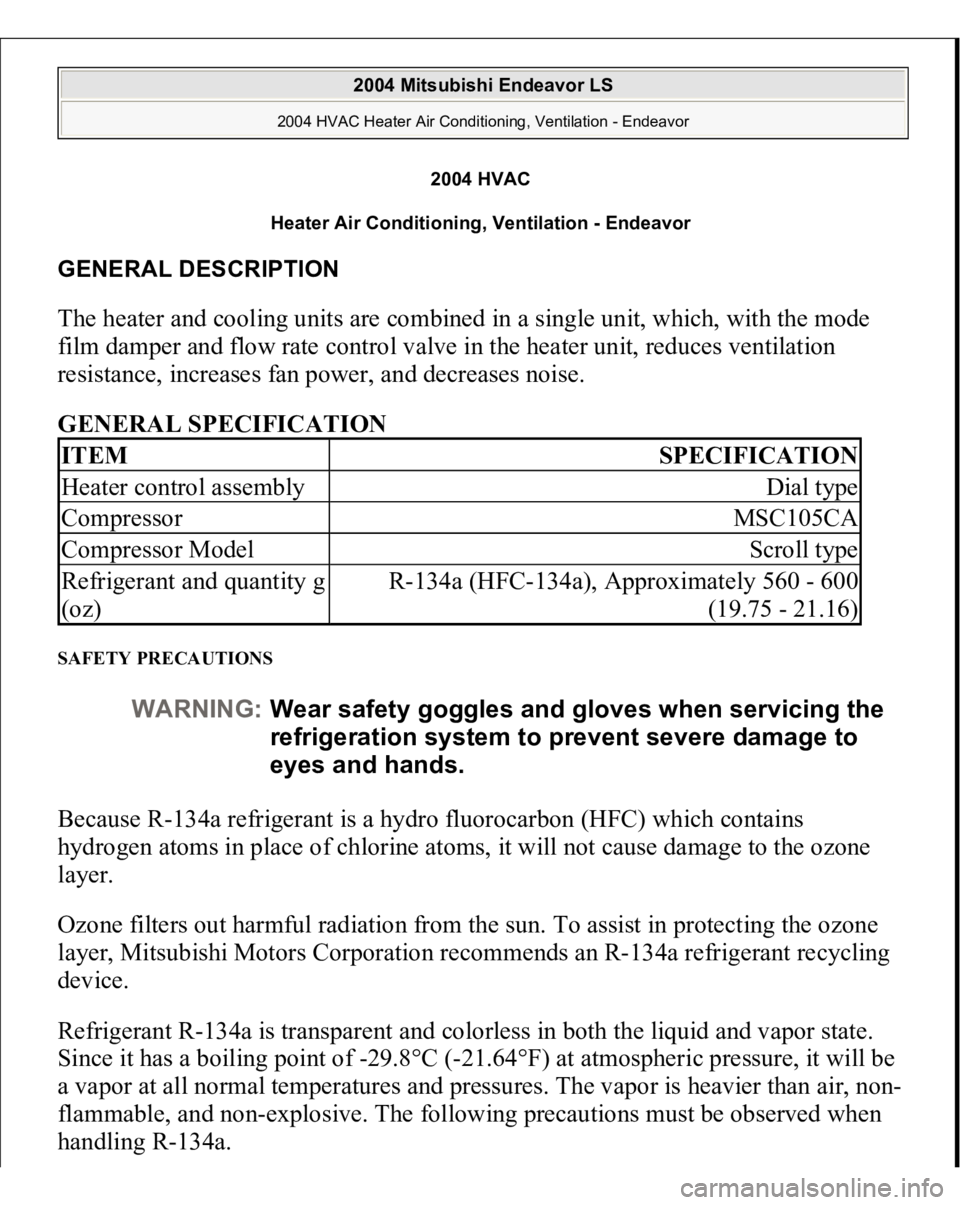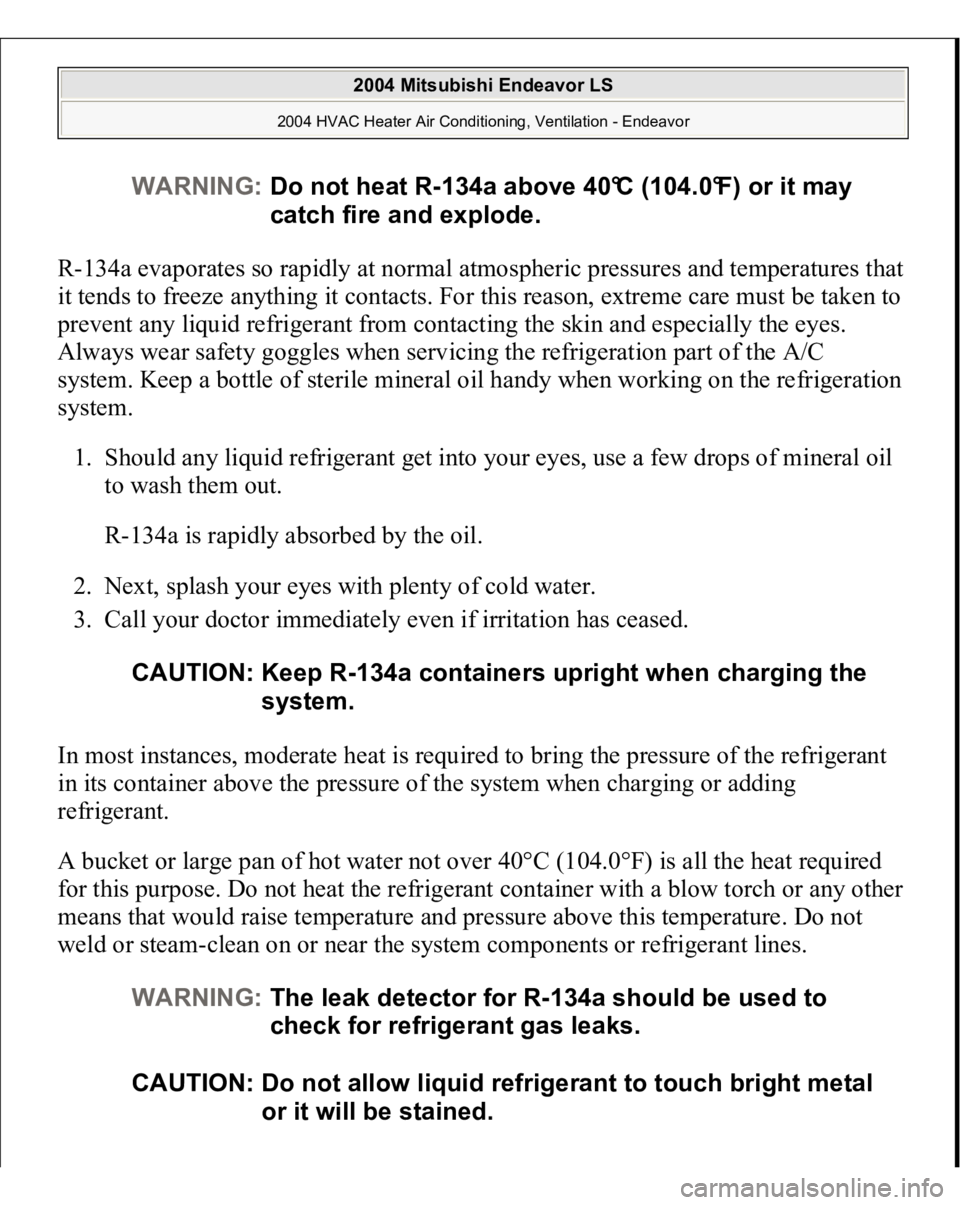Page 1528 of 3870
malfunction is a worn or damaged piston ring and/or cylinder inner
surface.
2. If the compression does not rise after oil is added, the cause is a burnt or
defective valve seat, or pressure is leaking from the gasket.
9. Connect the crankshaft position sensor connector.
10. Install the spark plugs and ignition coils.
11. Use the scan tool MB991958 to erase the diagnostic trouble codes.
NOTE: This will erase the diagnostic trouble code resulting from
the crankshaft position sensor connector being
disconnected.
2004 Mitsubishi Endeavor Limited
2004 ENGINE Engine - Endeavor
Page 1532 of 3870

3. With the engine idling, change the engine load (shift from N to D range, for
example) to make sure that there is no change in the level of abnormal noise.
If there is a change in the level of abnormal noise, suspect a tapping noise due
to worn crankshaft bearing or connecting rod bearing (In this case, the lash
adjuster is in good condition.).
4. After completion of warm-up, run the engine at idle to check for abnormal
noise.
If the noise is reduced or disappears, clean the lash adjuster (Refer to
ROCKER ARMS AND CAMSHAFT
). As it is suspected that the noise is
due to seizure of the lash adjuster. If there is no change in the level of the
abnormal noise, proceed to step 5.
5. Run the engine to bleed the lash adjuster system (Refer to LASH ADJUSTER
CHECK
.).
6. If the abnormal noise does not disappear after air bleeding operation, clean the
lash adjuster (Refer to ROCKER ARMS AND CAMSHAFT
).
Bleeding lash adjuster system 1. Check engine oil and add or change oil if required. NOTE: Parkin
g the vehicle on a
grade for a lon
g time ma
y decrease
oil in the lash adjuster, causing air to enter the high
pressure chamber when starting the engine.
NOTE: After parking for many hours, oil may run out from the oil
passage and take time before oil is supplied to the lash
adjuster, causing air to enter the high pressure chamber.
NOTE: In the above cases, abnormal noise can be eliminated by
bleeding the lash adjuster system.
NOTE: If the engine oil level is low, air is sucked from the oil
2004 Mitsubishi Endeavor Limited
2004 ENGINE Engine - Endeavor
Page 1534 of 3870
Fig. 26: Identifying High Pressure Chamber
Courtesy of MITSUBISHI MOTOR SALES OF AMERICA.
2. Idle the engine for one to three minutes to warm it up.
3. Repeat the operation pattern, shown in left figure, at no load to check for
abnormal noise. (Usually the abnormal noise is eliminated after repetition of
the ope
ration 1
0 to 30 tim
es.
If, howeve
r, no change is obse
rved
in
the leve
l of
NOTE: If air mixed with oil enters the high pressure chamber
inside the lash adjuster from the above causes, air in
the high pressure chamber is compressed excessively
while the valve is opened, resulting in an abnormal
noise when the valve closes. This is the same
phenomenon as that observed when the valve
clearance has become excessive. The lash adjuster can
resume normal function when air entered the lash
adjuster is removed.
2004 Mitsubishi Endeavor Limited
2004 ENGINE Engine - Endeavor
Page 1917 of 3870

A. Using End Yoke Holder (MB990767), fix the hub, and remove the axle shaft
nut.
B. Install Ball Joint Remover (MB991897) as shown. See Fig. 6
. Turn the bolt
and knob as necessary to make the jaws of Ball Joint Remover (MB991897)
parallel. See Fig. 7
. Tighten the bolt by hand and confirm that the jaws are still
in parallel. Tighten the bolt to disconnect the tie rod end and remove the self-
locking nut. CAUTION: DO NOT apply pressure (by vehicle weight) to the
wheel bearing when the axle shaft nut is
loosened.
CAUTION: DO NOT remove the self-locking but from the ball
joint. Loosen the nut and use Ball Joint Remover
(MB991897) to avoid possible damage to ball
joint threads. Hang Ball Joint Remover
(MB991897) with a cord to prevent it from falling.
NOTE: When adjusting the jaws of Ball Joint Remover
(MB991897) in parallel, make sure the knob is in the
position shown. See Fig. 7
.
CAUTION: DO NOT pull on the axle shaft. Be sure to use a
pry bar. When pulling the axle shaft out from the
transaxle, be careful that the splined part of the
axle shaft does not damage the oil seal.
CAUTION: DO NOT apply pressure (by vehicle weight) to the
wheel bearing when the axle shaft is removed. If,
however, vehicle weight must be applied to the
bearing to more the vehicle, temporarily secure
the wheel bearing by using Spacer (MB991000 or
MB990998) and Front Hub Remover and Installer
(MB991017). See Fig. 5
.
2004 Mitsubishi Endeavor LS
2004 DRIVE AXLES Axle Shafts - Front - Endeavor
Page 1941 of 3870
Q: Is the stabilizer bar in good condition?
YES: Go to Step 2.
NO: Replace it, then go to Step 3 .
STEP 2. Check the strut assembly for damage.
Q: Is the strut assembly in good condition?
YES: Go to Step 3.
NO: Replace it, then go to Step 3.
STEP 3. Retest the system.
Q: Is the malfunction eliminated?
YES: The procedure is complete.
NO: Return to Step 1 .
INSPECTION PROCEDURE 3: Poor Ride DIAGNOSIS
STEP 1. Check for improper tire inflation pressure.
Q: Is the tire inflation correct?
YES: Go to Step 2.
NO: Adjust it, then go to Step 4 .
STEP 2. Check for broken or deteriorated coil spring(s).
Q: Are the coil spring(s) broken or deteriorated?
YES: Replace the coil spring(s), then go to Step 4 .
NO: Go to Step 3.
STEP 3. Check for strut assembly damage.
Q: Is the strut assembly damaged?
2004 Mitsubishi Endeavor LS 2004 SUSPENSION Front - Endeavor
Page 1997 of 3870

2004 HVAC
Heater Air Conditioning, Ventilation - Endeavor
GENERAL DESCRIPTION The heater and cooling units are combined in a single unit, which, with the mode
film damper and flow rate control valve in the heater unit, reduces ventilation
resistance, increases fan power, and decreases noise.
GENERAL SPECIFICATION SAFETY PRECAUTIONS Because R-134a refrigerant is a hydro fluorocarbon (HFC) which contains
hydrogen atoms in place of chlorine atoms, it will not cause damage to the ozone
layer.
Ozone filters out harmful radiation from the sun. To assist in protecting the ozone
layer, Mitsubishi Motors Corporation recommends an R-134a refrigerant recycling
device.
Refrigerant R-134a is transparent and colorless in both the liquid and vapor state.
Since it has a boiling point of -29.8°C (-21.64°F) at atmospheric pressure, it will be
a vapor at all normal temperatures and pressures. The vapor is heavier than air, non-
flammable, and non-explosive. The following precautions must be observed when
handlin
g R-134a.
ITEM
SPECIFICATION
Heater control assembly
Dial type
Compressor
MSC105CA
Compressor Model
Scroll type
Refrigerant and quantity g
(oz)
R-134a (HFC-134a), Approximately 560 - 600
(19.75 - 21.16)
WARNING:Wear safety goggles and gloves when servicing the
refrigeration system to prevent severe damage to
eyes and hands.
2004 Mitsubishi Endeavor LS
2004 HVAC Heater Air Conditioning, Ventilation - Endeavor
2004 Mitsubishi Endeavor LS
2004 HVAC Heater Air Conditioning, Ventilation - Endeavor
Page 1998 of 3870

R-134a evaporates so rapidly at normal atmospheric pressures and temperatures that
it tends to freeze anything it contacts. For this reason, extreme care must be taken to
prevent any liquid refrigerant from contacting the skin and especially the eyes.
Always wear safety goggles when servicing the refrigeration part of the A/C
system. Keep a bottle of sterile mineral oil handy when working on the refrigeration
system.
1. Should any liquid refrigerant get into your eyes, use a few drops of mineral oil
to wash them out.
R-134a is rapidly absorbed by the oil.
2. Next, splash your eyes with plenty of cold water.
3. Call your doctor immediately even if irritation has ceased.
In most instances, moderate heat is required to bring the pressure of the refrigerant
in its container above the pressure of the system when charging or adding
refrigerant.
A bucket or large pan of hot water not over 40°C (104.0°F) is all the heat required
for this purpose. Do not heat the refrigerant container with a blow torch or any other
means that would raise temperature and pressure above this temperature. Do not
weld or steam-clean on or near the system components or refrigerant lines.
WARNING:Do not heat R-134a above 40°C (104.0°F) or it may
catch fire and explode.
CAUTION: Keep R-134a containers upright when charging the
system.
WARNING:The leak detector for R-134a should be used to
check for refrigerant gas leaks.
CAUTION: Do not allow liquid refrigerant to touch bright metal
or it will be stained.
2004 Mitsubishi Endeavor LS
2004 HVAC Heater Air Conditioning, Ventilation - Endeavor
Page 2364 of 3870
Fig. 273: Voltage Of A/C Pressure Sensor
Courtesy of MITSUBISHI MOTOR SALES OF AMERICA.
COMPRESSOR DRIVE BELT ADJUSTMENT Refer to
7. DRIVE BELTS (FOR GENERATOR, POWER STEERING OIL
PUMP AND AIR CONDITIONING
.
CHARGING Use the refrigerant recovery station to charge the refrigerant. METHOD BY USING REFRIGERANT RECOVERY AND RECYCLING UNIT Using the refrigerant recovery and recycling unit, refill the refrigerant. NOTE: Refer to the REFRIGERANT RECOVERY AND RECYCLING
UNIT'S INSTRUCTION MANUAL FOR OPERATION OF THE
2004 Mitsubishi Endeavor LS
2004 HVAC Heater Air Conditioning, Ventilation - Endeavor